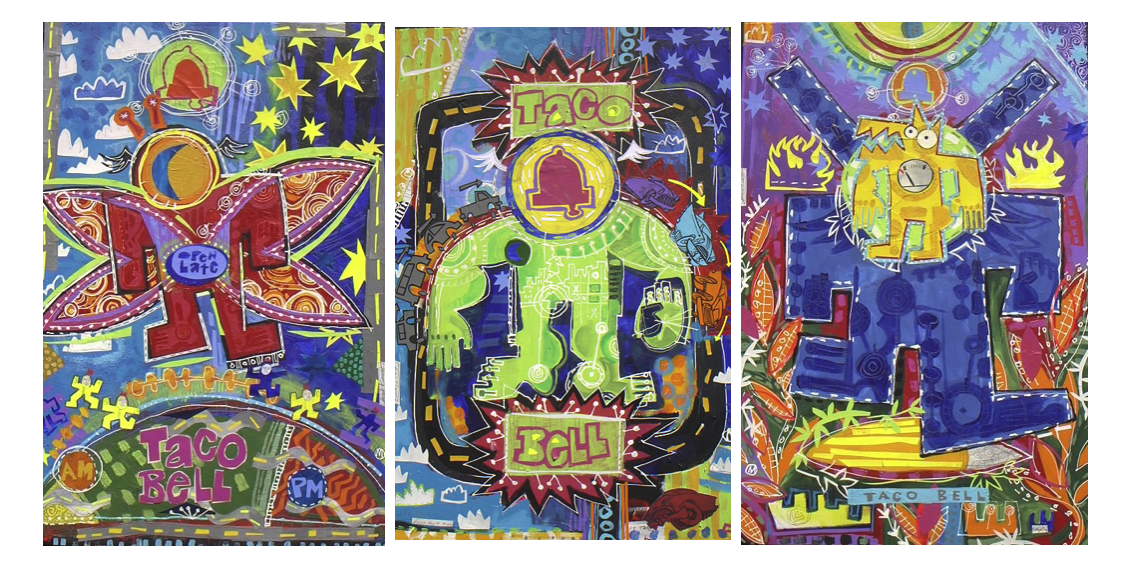
In 2015, a Taco Bell in Westlake, Ohio, made headlines when someone stole a printed canvas featuring an original artwork designed for the fast food chain. Fast forward nearly a decade, and there appears to be a thriving black market for the art, which has been a pillar of the restaurant’s decor for some 20 years.
The paintings are the work of artist Mark T. Smith, and he’s just as surprised as anyone to learn that the Maxfield Parrish-inspired art is being offered on eBay for upwards of $10,000.
“I think it’s really cool,” the artist told me. “There is this whole subculture of collecting and trading and stealing.”
Smith was already aware that his Taco Bell art had a bit of a following—he regularly hears from fans on Instagram asking about the work or sharing their photos in front of it. One girl even wrote to request a custom Taco Bell birthday card for her boyfriend—”she said he was the hugest fan of the artwork”—which he was happy to make.
A Taco Bell fast food restaurant in Pittsburgh. Photo by Paul Weaver/SOPA Images/LightRocket via Getty Images.
But Smith thought the 2015 theft was a one-off until he got a call from Ariana Bindman, a reporter for the San Francisco Chronicle. During a recent trip to Taco Bell, Bindman had gotten curious about the artwork. That led her to my article about the robbery, and, subsequently, to the black market for Smith’s designs.
The Chronicle spoke with one eBay seller who claimed to have gotten his canvases from someone involved in a Taco Bell renovation. Reddit users have told similar tales of Smith’s artwork being rescued from the trash or snapped up by management during a redecoration.
The genesis of the art campaign dates back to around 2002, when Smith flew to Louisville, Kentucky, to meet with Taco Bell executives. The restaurant’s parent company, Yum Brands, had recently acquired Long John Silver’s and A&W, and was looking to open new locations combining the different fast food chains.
“They were building prototypes in Kentucky of these multi-brand stores. The problem they hired me to solve was how to integrate these interiors with these brand colors that don’t necessarily work together,” Smith explained.
What he came up with was a trio of vibrant works made with, acrylic, crayon, and layers of cut paper titled Drive Thru Man, Mothman, and Empty—artworks that have helped define the aesthetic of Taco Bell restaurants across the country for over two decades.
It’s definitely one measure of artistic success—even without factoring in the illicit sale of the art.
“With this project, I was trying to reach out to a group of people that I thought did not get a lot of exposure to art, and it really worked!” Smith said. “It entered the zeitgeist in some interesting way and it’s sort of been being kicking around for 20 years.”
A graduate of Pratt Institute in Brooklyn, Smith has worked with brands including MTV, Absolut Vodka, and Pepsi, and created an album cover for British reggae group UB40. Most recently, he installed a digital mural, Harmony in Progress, for the Valley Bank corporate headquarters in Morristown, New Jersey.
Mark T. Smith’s Empty and Drive Thru Man hanging on the wall of a Taco Bell. Photo courtesy of the artist.
The asking price for the Taco Bell works can vary. As of press time, there are eBay listings for Drive Thru Man for $8,499.99, Mothman for $5,999, and Drive Thru Man and Empty sold together for $10,500. Strangely, there is also a full set for the comparative bargain of $1,000.
Smith actually worked with Yum’s research and development department as an art director for several years. There were originally going to be five different art campaigns with four other artists, but Smith’s work was the only one ever installed in Taco Bell stores. (Paintings he made for A&W and Long John Silver’s also never saw the light of day; Yum sold those two chains in 2011.)
Yum did not respond to request for comment, but Smith estimates his work went into some 4,000 stores for the chain. It remains unclear if Taco Bell is still printing new copies of the paintings, or how many restaurants still include them in their decor.
As part of the project, Yum purchased both the original artworks and the intellectual property for the designs. Smith, it turns out, doesn’t even own a copy of his coveted designs—not that he’s tempted by the eBay listings.
“I’m not sentimental like that,” he said. “I’m standing in my studio now, and it’s filled with canvases and drawings and frames. So no, no more stuff.”
You also probably won’t spot him at Taco Bell anytime soon.
“I’m not a fast food-eater,” Smith admitted. “My stomach is a little too delicate for that.”